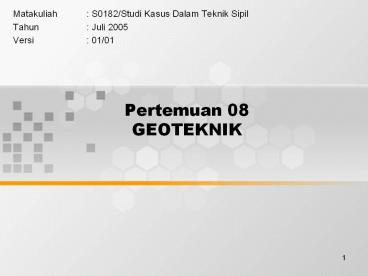Pertemuan 08 GEOTEKNIK - PowerPoint PPT Presentation
Title:
Pertemuan 08 GEOTEKNIK
Description:
Title: Judul Author: Debby Tanamal Last modified by: Amelia Makmur Created Date: 4/16/2005 3:08:17 AM Document presentation format: On-screen Show Company – PowerPoint PPT presentation
Number of Views:142
Avg rating:3.0/5.0
Title: Pertemuan 08 GEOTEKNIK
1
Pertemuan 08GEOTEKNIK
- Matakuliah S0182/Studi Kasus Dalam Teknik Sipil
- Tahun Juli 2005
- Versi 01/01
2
Learning Outcomes
- Mahasiswa dapat membandingkan kasus-kasus yang
terjadi dengan berbagai alternatif yang dipilih ?
C4
3
Outline Materi
- Analisa pemecahan masalah
- Beberapa alternatif pemecahan masalah
- Kasus kegagalan konstruksi yang mungkin terjadi
4
Slope Failures
- On September 12 of 1717 an avalanche cascaded
down the Troilet, Italy glacier, gaining speed on
a cushion of air, reaching a falling velocity of
320km/hr over a 3600 m fall. Two towns were
destroyed, with 7 people killed and 120 cows
lost. The slosh of the avalanche ran up the far
side of the valley at a speed of 125 km/hr. - Snow avalanches, rock avalanches, debris flows,
mud flows, and rock falls are failures of the
surface under the action of gravity. The basic
physics controlling the stability or instability
of landforms is relatively simple and well
understood, but the hazards are not always
recognized, even when geological deposits
indicate past slope failures in the region. In
many cases, surface instabilities of this type
are compound events, associated with earthquake
or volcanic processes, which enhance their
catastrophic potential. From the surface geology
perspective, landslides and debris flows are
important landscape modifying agents, and play as
large of a role in eroding topography and
depositing debris as is played by other
mechanisms such as rainfall and runoff.
5
Slope Failures
6
Slope Failures
- There are two basic classes of surface failures
- 1. Single rock failures
- These often are blockfalls of individual rocks
falling from an eroding surface, which is usually
very steep, or "over steepened" beyond the stable
angle of repose for the surface materials. The
blocks pile up in an apron of debris, called a
talus slope or talus cone. - 2. Flows of the surface, involving large volumes
of rocks and soil. - Slow flows- (creep, solifluction, earthflows)
- Fast flows- (snow avalanches, landslides,
mudflows, debris flows) - Fast flows leave jumbled deposits, often piles
upon piles, that can be recognized in the
geological record by their shape and the poorly
sorted (many rock sizes intermixed) nature of the
deposit. The fast flows tend to be fluidized,
either by a mixture of rock and air or rock and
water. The relative components of the mixture
determines how the failure will be named a
mudflow is water with lots of clay and silt
material, which is a runny mud, while a debris
flow is a jumble of rock fragments with some
water. The fluidized nature of the flow accounts
for the last flow velocities attained, and the
associated hazard posed.
7
Slope Failures
8
(No Transcript)
9
Landslides
- Landslides occur when a portion of a hillslope
becomes too weak to support its own weight. This
weakness is generally initiated when rainfall or
some other source of water increases the water
content of the slope, reducing the strength of
the materials. Other causes of landslides include
earthquakes and loud sounds. Many types of
landslides move seasonally or periodically and
may lie dormant for years. - Landslides are generally classified into slides,
falls and flows. Slides move as large bodies by
slipping along one or more failure surfaces.
Falls of rock or soil originate on cliffs or
steep slopes. Large rockfalls can be catastrophic
events. An earthquake off the coast of Peru in
1970 started a rockfall which accelerated to more
than 170 miles per hour and buried more than
18,000 people. Flows are landslides that behave
like fluids. Mudflows involve wet mud and debris.
Earthflows involve wet, claylike material.
Solifluction is the downslope flow of soil that
occurs on arctic and alpine hillsides when thawed
ice or snow saturates the soil cover.
10
Landslides
- Landslides constitute a major geologic hazard
because they occur in all 50 states, causing 1-2
billion in damages and more than 25 deaths each
year. Landslides commonly occur with other major
natural disasters, such as earthquakes and
floods. The 1980 eruption of Mount St. Helens in
Washington was preceded by the development of a
large landslide on the north side of the volcano.
The Northridge earthquake in 1994 in the San
Fernando Valley triggered thousands of landslides
in the Santa Susanna Mountains north of the
epicenter.
Landslides
11
Landslides
- Even though landslides are generally not as
spectacular or costly as earthquakes, major
floods, hurricanes and some other natural
catastrophes, they are more widespread and may
cause more property loss than any other geologic
hazard. Much of the damage attributed to
earthquakes and intense storms is really due to
landslides. - The most expensive landslide in U.S. history
occurred in Thistle, Utah, in the spring of 1983.
It reached 1/2 mile from top to bottom and ranged
in width from 1,000 feet to about 1 mile. Total
costs attributable to this landslide exceeded
500 million. In May of 1970, an earthquake in
Peru cost about 70,000 lives. In Alberta, Canada,
in 1903, a mass of about 30.6 million cubic
meters slipped from the top of Turtle Mountain
and fell to the floor of the adjacent valley. The
mass of earth and rock spread across a 2 mile
wide valley, annihilating the town of Frank and
killing 70 people.

